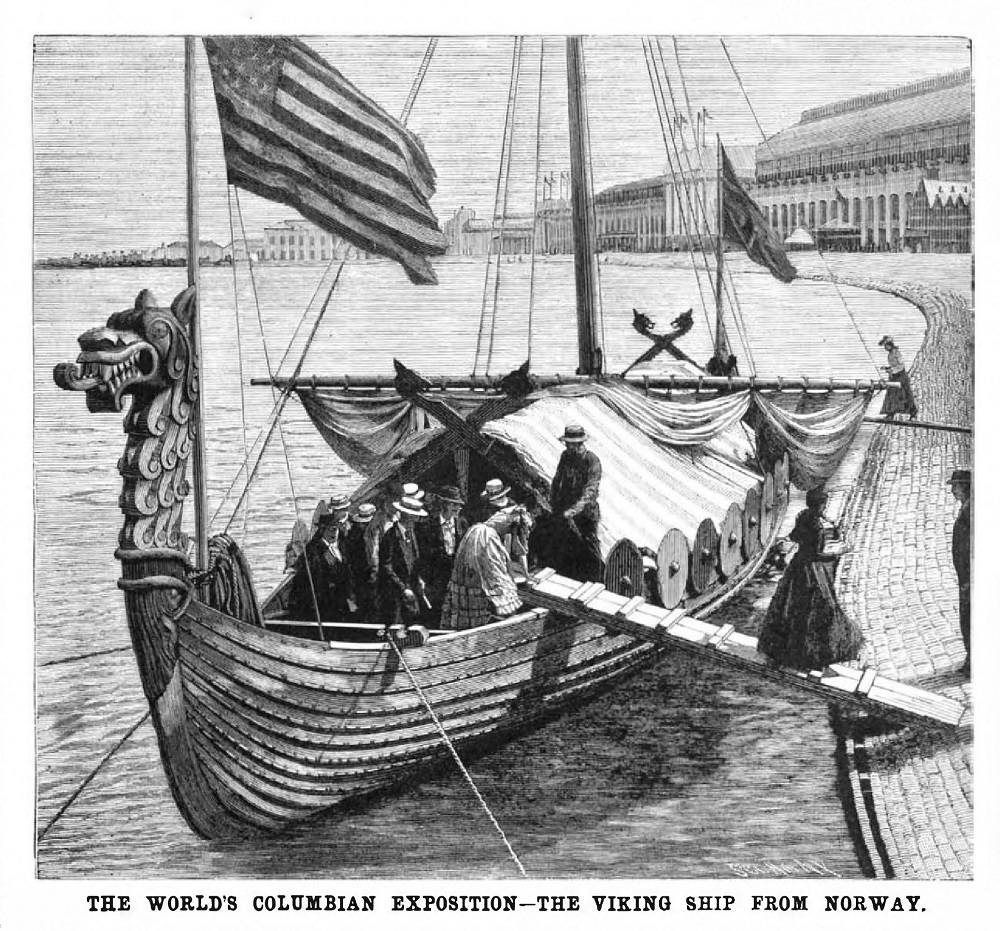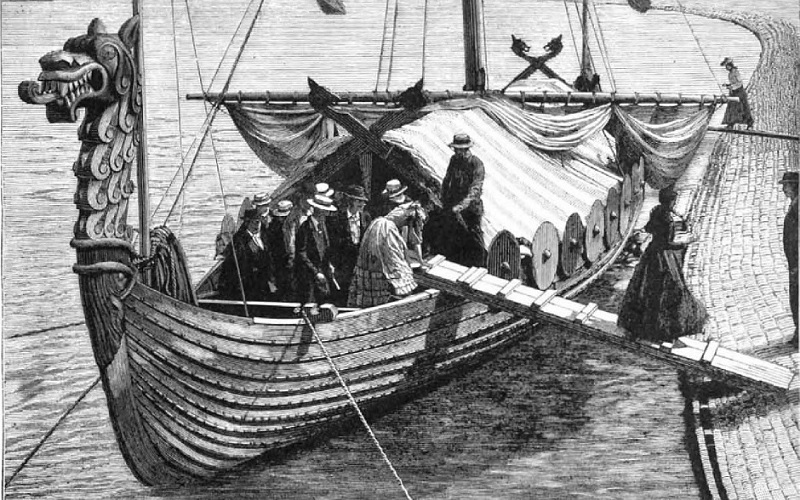“The presence of the Viking ship in one of our ports and her subsequent visit to Newport and New York and the trip up the Hudson, through the Erie Canal down the Great Lakes to Chicago and the ‘White City’ marks a historical event of no small importance.”
—The Chautauquan, August 1893.

The Viking from Norway at the 1893 World’s Fair in Chicago. [Image from Scientific American, Aug. 19, 1893.]
The description below of The Viking’s voyage to America, written by Professor Hjalmar Hjorth Boyesen (1848–1895) of Columbia University, was published in the January 1894 issue of The Chautauquan. Boyesen authored what is considered the first novel by a Norwegian immigrant in America, Gunnar: A Tale of Norse Life (1874). Boyesen also authored “A New World Fable” published in the December 1893 issue of Cosmopolitan magazine, which we reprinted here.
The Viking Ship is one of the rare large structures surviving from the 1893 World’s Fair. This treasure is being preserved and exhibited in Geneva, Illinois, by the Friends of the Viking Ship. We encourage readers to support their efforts.
THE VOYAGE OF “THE VIKING”
By Professor Hjalmar Hjorth Boyesen, Columbia College
It is well known that the people of Norway have always disputed with Columbus the honor of America’s first discovery. The old Norse sagas, which are family chronicles and historical records from the twelfth and thirteenth centuries, seem to leave no doubt that the Icelander Leif Ericson, the son of the turbulent Norwegian chieftain Eric the Red, landed on the shores of this continent in the year 998 A. D., and that his kinsman Thorfinn Karlsefue repeated Leif’s voyage and made an unsuccessful attempt to found a settlement about the year 1,000 A. D.
In what locality this settlement was has never been exactly determined, some holding that it was on the Massachusetts coast, in the neighborhood of Cape Cod, others contending that the description of the land given in the “Saga of Eric the Red” indicates the vicinity of Newport, R. I.; and again others placing the “Vineland” of the saga in Nova Scotia. I shall not undertake to settle this dispute; but will only call attention to it. What is worthy of note, however, is that the manuscript of the saga to which I have referred is one hundred and sixty years older than the Columbian discovery. And the fact that besides locating a great unknown land to the westward, it also mentions the Indians whom the Norsemen called Skrellings is to me sufficient proof that the voyages of Leif and Thorfinn did take place, and that accordingly the Norsemen are entitled to the honor of having been the first discoverers of the American Continent.
The Viking. [Image from The Chautauquan, Jan. 1894, p. 420.]
Captain Magnus Anderson of The Viking. [Image from The Chautauquan, Jan. 1894, p. 421.]
In spite of this protest, however, an invitation was issued for a national subscription and the required amount was procured, mostly in the small sums of ten, twenty-five, and fifty cents. The undertaking, I am told, was not popular with the upper classes, while it appealed strongly to the imagination of the seafaring population which readily kindles at an enterprise with a touch of heroism. It was first proposed to christen the ship Leif Ericson; but for some reason the name The Viking was preferred. In every particular, even to the minutest detail, she was made to conform to her ancient model; and no single feature was introduced which was at variance with the sea-faring customs of our Norse ancestors, nine hundred years ago. I say no single feature; but I ought, perhaps, to have made one exception. Although there was no compass visible when I was on board, the captain confessed that his knowledge of astronomy was not sufficient to enable him to dispense with that useful instrument. A quadrant and a barometer were perhaps also anachronisms; though strictly speaking they did not belong to the vessel, but to the personal equipment of the captain, which, of course, in many respects differed from that of an old Norse marauder setting out in quest of booty and martial fame.
The Viking was built during the past winter at Sandefjord, where the original Viking ship had been found. She was launched in March in the presence of a great concourse of people, and amid great enthusiasm. The beauty of her lines, and her graceful shape aroused universal admiration; and many were those who declared that the art of shipbuilding had been lost with the old Norsemen, and was now on the point of being recovered. What ugly, unwieldy, clumsily constructed hulks were the caravels of Columbus, and both the warships and the merchant vessels of the fifteenth and sixteenth centuries, compared to this swift and slender ocean racer every single feature of which was the result of centuries of marine experience.
But if the enthusiasm had been great at the launching, far greater it became when The Viking had had a chance to show her seaworthiness. On the way from Sandefjord to Christiania she was caught in a furious storm with snow and sleet. She vanished from the sight of land and it was feared that she was lost. But though considerably retarded The Viking turned up in Christiania in due time; and all her crew bore witness to the fact that she had behaved splendidly.
”She rode the waves like a duck,” said the mate in describing this experience, “and it was simply wonderful to see how she eased herself in her joints, as if she had been alive, and slid away from seas high enough to bury her.”
“That gilt dragon head seemed to snort smoke in the squall,” declared another member of the crew; “but it always kept straight ahead and it was fun to see how it flashed when the sun shone on it.”
The Viking under way. [Image from The Chautauquan, Jan. 1894, p. 422.]
The first question which the visitor to The Viking is apt to address to the captain or mate is this: “Where do you sleep? I see neither berths nor hammocks.”
“Well, we sleep here,” the captain replies, pointing to the spaces between the sides of the ship and the two long row-benches—I can scarcely call them thwarts, as they extend longitudinally from prow to stern. The rower sits them astride, when wielding his oar. A striped canvas awning, supported by two pairs of crossed beams, ending in dragon heads, affords a scant shelter to the crew in the night and protects them from the glare of the sun in the daytime.
There is an open movable hearth in front of the mast, where fire is made, and an iron pot may be suspended from a curious linked crane. Under the row-benches are seen a number of painted or carved ship-chests containing the bedding and the clothes of the men. A long board which maybe put up and taken to pieces, serves as a dining table; though I fancy it is rarely put up when the ship is at sea.
I have kept to the last the finest and most picturesque features of The Viking, viz., the golden dragon’s head, surmounting a long scaly neck, forming the prow; and the equally ornamental tail, ending in a vigorous flourish, forming the stern. It is marvelous how readily the imagination accepts these hints, and identifies the hull of the ship, as it proudly breasts the waves, with the body of the fabulous monster. The sixteen shields which are fastened along the gunwale on each side are easily transformed into scales and the oars by a little stretch of fancy are made to serve as fins, that is, if dragons have fins, of which I cannot be absolutely sure.
It had been determined by the committee having charge of the equipment of The Viking that she should sail in April from the city of Bergen on the western coast of Norway. Captain Magnus Anderson, who, on account of his experience and his prominence in initiating the enterprise, had been given the command, advertised for a crew of thirteen men; and received instantly nearly three hundred applications. It was then resolved to select the crew according to locality, so as to give as far as possible every province of Norway one representative. A sturdy lot of men, the very flower of Norse seamanhood, were thus brought together, all filled with the adventurous spirit of their fathers, who courted danger like a mistress.
On April 30, The Viking set sail from Bergen, accompanied by a large flotilla of craft of all descriptions. The burgomaster, the city council, and many other dignitaries formed part of the escort; and the friends, sweethearts, and kinfolk of the crew kept waving their handkerchiefs and sending tearful greetings in speech and song to the departing “vikings.” It was felt by all that it was a tremendously hazardous undertaking upon which they were entering; and the hearts of their friends stood still, when they fancied that frail open boat, only 78 feet long, buffeted by the huge waves of the Atlantic.
The Viking had not been long at sea before she had a chance to test her mettle. On May 10, when north of the Orkneys, she was caught in a heavy gale ; and a telegram was sent from London to New York, announcing that The Viking had been sighted in a storm which probably had driven her back to the coast of Norway. But those who telegraphed that intelligence knew little of the pluck of Captain Anderson or of the seaworthiness of The Viking. That stanch little craft kept bravely ahead, though she shipped several seas, and the crew was kept busy bailing, until their horny hands were sore and the blood oozed forth under their finger nails. But not once did they think of turning tail; for they were all buoyed up by the thought that they had the honor of Norway in their keeping, and that, in a measure, they were to prove her claim to the glory of having first discovered the New World.
The Viking in mid-ocean. [Image from The Chautauquan, Jan. 1894, p. 423.]
After this patriotic celebration, old Neptune seems to have dropped into a gentler mood; for the winds lulled somewhat and ceased to howl in such wild discordant choruses. The rest of the voyage was eventless and perhaps a trifle dull. A number of Atlantic steamers were spoken; and offered to take The Viking in tow—which offers were scornfully rejected.
“Those Columbus washtubs which are as broad in the bow as in the beam may advertise their paltriness by being towed,” said one of the crew, in relating the incident, “but you won’t catch The Viking following their example.”
The fact is these modern Vikings have a great contempt for the Columbus caravels, and never refer to them by any other name than ”the Columbus washtubs.”
The Viking in New York harbor. [Image from The Chautauquan, Jan. 1894, p. 424.]
Of the many later festivities I have not the space to speak. The Viking arrived in the middle of July at Chicago, by way of the Erie Canal and the Lakes, and formed part of the exhibit of Norway at the World’s Fair.
The Viking being exhibited on the shore line of Lake Michigan at the 1893 World’s Columbian Exposition. The U.S. Government Building stands in the left background. [Image from Bancroft, Hubert Howe The Book of the Fair. The Bancroft Company, 1893.]

